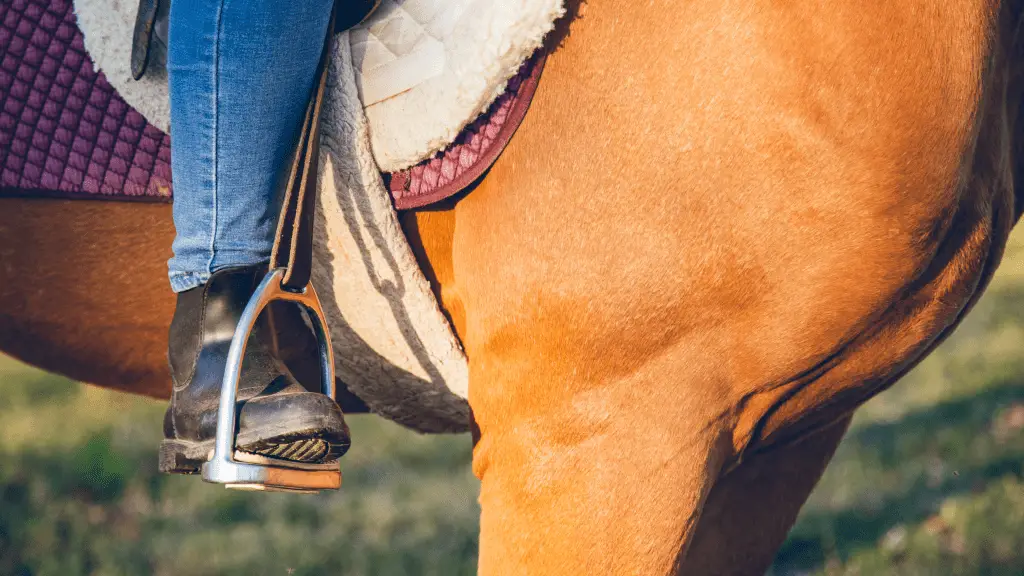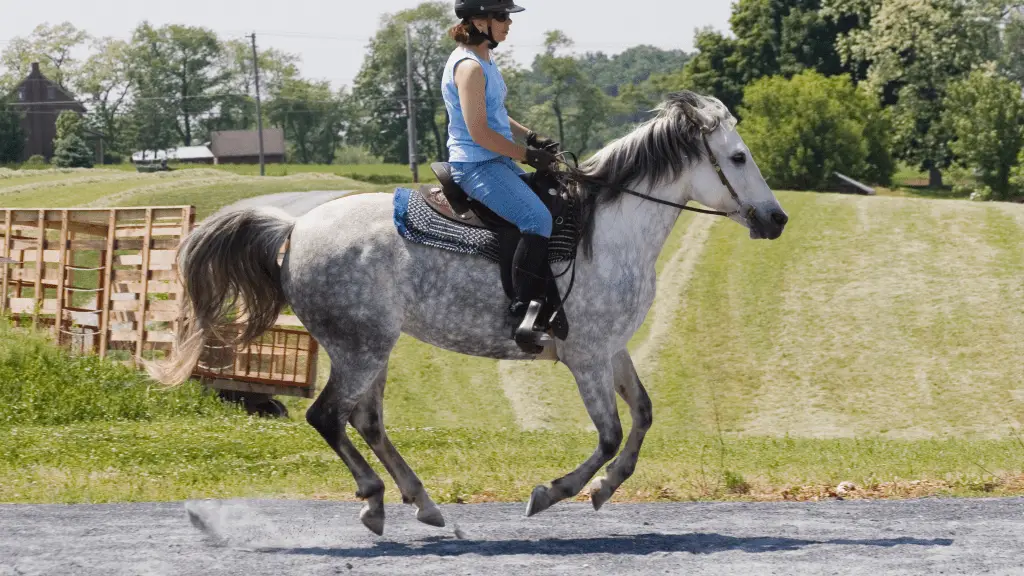You feel your heart start to race as you begin to lose your balance in the saddle.
You try your best to grip with your legs to stay on. You are cantering in your lesson and your foot came out of one of your stirrups… again.
Why do you keep losing stirrups in canter? What are you doing wrong?
It’s so frustrating, nerve wracking and you keep making the same mistake almost every time you canter.
There are several reasons why this could be happening, and knowing why is part of the solution.

My Experience With Losing Stirrups At The Canter
This is something I used to struggle with when I was learning to canter and even after cantering for years I would sometimes still lose a stirrup or both.
Luckily I learned how to slip my foot right back into the stirrup.
One Experience Learning To Canter With Buddy
Anyway, I remember a couple years into my equestrian journey I was taking some lessons on this bay off the track thoroughbred named Buddy at a barn in Massachusetts called Evenstride. I think it was around the year 1999 or 2000.
Although I had been riding weekly for a couple years I was not a natural and had been stuck at the trot for most of that time!
So they were starting me cantering on the lunge line. It was not pretty. Buddy would race at the trot and fall into the canter. I felt nervous, out of control, unbalanced and all over the place.
I could feel my self teetering to the outside of the circle. My reaction was most often to grab the front of the saddle hold on for dear life and grip with my legs trying to stay on. This often caused Buddy to speed up in the canter.
Before you know it I’m bouncing, my legs are drawing up and boop my foot comes right out of the stirrup usually the inside sometimes both.
Thankful For Buddy And Other Horses I Have Learned On
I feel bad for Buddy thinking back to all those years ago, for putting up with my bad riding.
I am lucky he listened to my instructor when she asked him to come back down to a walk which I would then struggle to get my feet back into the stirrups.
It took me a long time, a lot of horses and a lot of lessons before I started to ride with a more effective seat where I have been able to keep my feet in the stirrups most of the time.
Why I Wanted To Share
I just wanted to share this because I wanted to encourage you that you are not the only one. It is part of the journey as frustrating as it can be.
You can get past this and eventually you will ride better and be able to keep your stirrups when you canter.
Why Do I Keep Losing My Stirrups In Canter?
In this blog post I am going to help you understand why you might be losing your stirrups at the canter.
I will be listing the 7 most common reasons for this annoying problem. You will have to decide which one of these reasons is yours.

7 Reasons For Losing Stirrups In Canter
These are top 7 reasons you might be losing your stirrups at the canter, but there could be others.
I am just sharing what I have discovered to be the most typical reasons why.
If you have any other ideas, please share them in the comments section at the bottom of this post!
1. Stirrups Too Long
Stirrup length is usually the cause for losing your stirrups at the canter only when they are truly too long.
Whether they are shorter or longer for different types riding disciplines, you should be able to keep your feet in the stirrups at different lengths.
But correct stirrup length does help.
Also, it tends to be little bit easier to keep your feet in the stirrups with shorter stirrups. This is because riders tend to draw up their legs instead of lengthening them down, like they should.
Even so, like I said before, you should be able to ride with shorter or longer lengths and not lose your stirrups.
However if by chance your stirrups are truly too long for you then it will comprise your leg position and make it difficult to keep your stirrups.
You can tell if the stirrups are too long by looking at where your heels fall when you lengthen or stretch your legs down.
You should have a bend in your knees, with your heel positioned under your hips and your heels should be level or lower than your toes.
If you are struggling to reach the stirrups and your can only reach them with a straight leg or with your heels up like you are tippy toeing then your stirrups are too long.
Like I said before generally it is easier for a rider to learn with slightly shorter stirrups. Though not so short it puts them into a chair seat.
The effect of this “chair seat” puts more of your weight in your seat and lower back and less in your legs.
ANN GUPTILL – Dressage Today
2. Uneven Weight In The Stirrups
You can lose your stirrups at the canter from uneven weight in the stirrups.
The foot with less weight can lose contact with the stirrup pad at different times with the motion of the horse’s canter.
It is also difficult to balance with uneven stirrups.
Your foot will either slide deeper into the stirrup or slide right on out.
It is a good idea to check your saddle is centered and the girth is secure enough so that the saddle won’t slide around.
Then make sure the stirrups are even length on both sides.
Lastly it is up to you to keep equal weight it both stirrups, which can be a challenge if your horse is unbalanced or leaning around turns.
3. Gripping With Legs
Gripping with your legs causes tightness and tension in both you and your horse.
Your joints become stiff, you don’t move with the horse as well and your legs tend to rise up in the saddle.
The big thing here is your legs rising up off the stirrups. You may lose one or both stirrups if you grip with your legs while cantering.
Often what happens is the rider grips with their knees, which creates a problem of the calves and heels coming up.
Usually a rider grips for a couple of reasons.
- You might have thought that gripping is what you are supposed to do in order to stay on.
- Your instincts tell you to grip because you feel unbalanced like you might fall off.
4. Bouncing
If you are wondering how to sit a bouncy canter this is not what I am talking about.
Although a horse with a bouncy canter can contribute to losing your stirrups because it is harder to move along with that type of canter.
That said bouncing happens when you are not moving with the horse’s movement.
If you are bracing or gripping to try to stay on you will bounce at the canter.
If you are sitting there doing nothing “like a sack of potatoes” you will bounce.
If you are trying to move with the horse but are out of sync with the horses movements you will bounce.
When you bounce in the saddle your foot can easily come out of the stirrups while cantering.
To stop bouncing at the canter read the following blog post: How To Stop Bouncing At The Canter: A Guide For Sitting The Canter
5. Not Weighting Heels
When you don’t have any weight in your heels, you may look like you are on your tippy toes.
It is typically because your legs are lifting up, and you are still trying to keep contact with the stirrups. You heels begin to rise higher than your toes.
This mainly happens when you grip your legs or are tight in your calves or ankles.
Riding in this position will make it much more likely to lose a stirrup or have your foot slide deeper through the stirrup.
When your foot slides through the stirrup to the heel you become unable to put weight into your heels, because your toe is not in the right spot to allow your heel to sink down.
You need to know how to keep your foot in the stirrup, which is the ball of your foot on the stirrup pad.
You want to think about lengthening your leg down and deepening your heels.
Proper position begins in the foot with a rather deep heel. This elongates the calf, making it more functional and anchors the leg.
Bernie -equestriancoachblog.com
BUT!! Not forcing your heels down and bracing with your ankles.
6. Braced Ankles
You can brace your ankles whether your heels are lifted or your heels are down.
Often you are told to put your heels down. The result may be that you are forcing your heels down and bracing.
When you force your heels down continuously your ankles lose the ability to be flexible and absorb the horse’s movement.
Locked joints are in their end positions, they have no rebound, no suppleness, no suspension. This is why riding with your heels jammed down at each phase of the movement will never let you also maintain a supple, deep seat in sitting trot and canter.
Aspire Equestrian
You can lose your stirrups when you brace even if your heels are down.
You want to let your ankles, knee and hip joints be supple, moveable and flexible, moving with the horse’s movement and absorbing the shock.
7. Swinging Legs
Speaking of bracing and forcing your heels down. This can actually contribute to your legs swinging especially when coupled with a chair seat.
Chair seat is once again a culprit here for swinging legs, because you are constantly behind the motion, and unbalanced with your legs swinging in front of you.
When your legs swing they can easily slide through or out of the stirrups.
Your legs can also swing when you are not moving in sync with the horses motion.
Another thing that can cause your legs to swing at the canter is when your legs are too loose on the horses sides. There is a place between too loose and gripping the horses sides.
You want your legs to be draped around the horses sides like a wet cloth.
2 Helpful Videos If You Are Losing Stirrups In Canter
- Watch on YouTube how to keep your heels down in canter by Amelia Newcomb Dressage.
- Also check out on YouTube how do you keep the stirrups in the canter by Your Riding Success.
Here are some other posts for more help with the canter!
Final Thoughts On Why You Lose Your Stirrups At The Canter
I think the most common reason for losing stirrups when riding at the canter is from gripping with your legs. Is this something you’ve been doing at the canter?
Out of the list of potential reasons can you identify which you have been doing that have been causing you to lose your stirrups?
I hope that with knowing why you are losing your stirrups at the canter you can then begin to work on fixing the problem.
If you are taking riding lessons, tell your instructor what you discovered so they can help you and guide you on how to improve.
The next post will be tips on how to stop losing your stirrups at the canter.
Comment Down Below:
Let us all know down in the comments. Which one of these is the reason you lose your stirrups at the canter?
Cheers, Kacey


